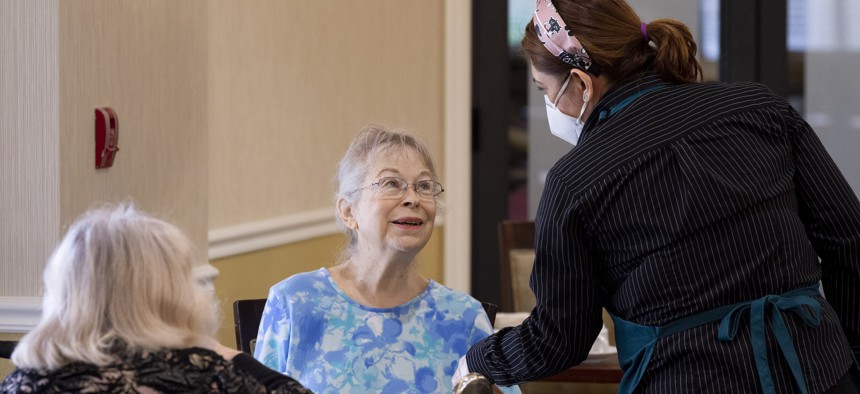Housing and care costs leave aging Americans with limited options

Assisted living and in-home care are increasingly out of reach for many low- and middle-income seniors. Paul Bersebach/MediaNews Group/Orange County Register via Getty Images
With adults over 65 already 17% of the U.S. population, communities need to prepare for the growing number of older adults who need both affordable housing and care, experts say.
It’s difficult for just about anyone to find housing these days. But for older adults who need care as well as safe housing, finding affordable living arrangements can be a herculean task, and one that will only become more challenging as demand for care grows with the aging population.
Over the last decade, the number of older adults increased 34% and now makes up 17% of the overall population, according to a new report from the Joint Center for Housing Studies of Harvard University. By 2040, the number of households headed by someone 80 or older will more than double.
The data on aging adults’ finances paints an ominous picture. Nearly 11.2 million adults over 65 spent more than 30% of their income on housing in 2021, a record high up from 9.7 million in 2016. Of that group, more than half are spending at least 50% of their income on housing. So it’s little surprise that so many older adults cannot afford the extra expense of in-home care or assisted living.
“The combined cost of housing and daily care are beyond the means of most people,” said Jennifer Molinsky, the director of Harvard’s Housing an Aging Society Program and the report’s lead author, during a panel discussion Thursday. And when she says “most people,” Molinsky said she means “not just people with very low incomes but also a growing number of people with more moderate and middle incomes.”
Older adults typically have two options. They can age at home with long-term care, relying on family, friends or hired caretakers to help with everyday tasks like dressing and bathing. Many will choose this option as it allows them to remain in a community and space they’re familiar with. Plus, they often assume aging in place is less expensive than moving to an assisted living facility.
Recent expansions of paid family leave programs in 13 states and Washington, D.C., offer some support to adult children caring for their parents, but in many cases, it’s not enough to compensate loved ones who have their own jobs and families. And because a hired caretaker costs on average more than $100 a day, only 14% of older adults living alone in major metro areas can afford in-home care on top of housing costs, according to the report.
Those who want to age in place also face the expense of maintaining a home and updating it to be accessible. Fewer than 4% of homes in the U.S. have the features most critical for older adults, the report notes, including single-floor living, no-step entries and wide doorways and hallways.
In some parts of the country, assisted living is more affordable than care at home. In San Diego, California, for example, the median annual cost of assisted living is $66,800 compared to $76,000 for in-home care. Still, in a city where the median income for adults over 75 is just $29,000, only 20% of those households can afford assisted living. Nationwide, only 13% of households can afford assisted living without dipping into assets, according to the report.
While both in-home care and assisted living have drawbacks, both models are needed to house the growing population of seniors, said Bob Kramer, co-founder and strategic advisor at the National Investment Center for Seniors Housing and Care. “We need everything. We need more options for people to choose [from] and that people can afford, whether they want to stay home or whether they want to move into different settings.”
One initiative offering more options is the Program of All-Inclusive Care for the Elderly, or PACE. Established by the Centers for Medicare and Medicaid Services, these programs are available in 32 states and Washington, D.C. They offer comprehensive care to older adults, covering everything from checkups and hospital visits to transportation and home care, to allow people to remain in their homes. They’re administered by nonprofits or government entities and funded by enrollees’ Medicare and Medicaid payments. These programs have been gaining popularity over the last few years, according to Kramer.
Massachusetts is working to ensure each of its 351 cities and towns has access to a PACE program, according to Elizabeth Chen, the commonwealth’s secretary of elder affairs. Massachusetts also hires resident service coordinators to live in senior affordable housing developments. These coordinators have a variety of responsibilities, including providing wellness programs, facilitating recreational activities and helping residents connect with public assistance programs. The supportive housing model also reduces emergency room visits and hospital admissions, Chen said.
While public programs help ease seniors’ burdens, the lack of affordable housing is a root problem that needs to be addressed, Chen noted.
“We're all living longer thanks to the magic of modern medicine, and that's good, [but] we need to produce more units,” she said. Gov. Maura Healey stepped up in October when she proposed the $4 billion Affordable Homes Act. The bill includes $200 million for a housing innovations fund to explore alternative housing for seniors, veterans and people experiencing homelessness and will streamline the permitting process for accessory dwelling units, or ADUs.
State and local policies supporting ADUs are increasingly popular. Sometimes known as granny flats, the small homes not only boost housing stock, but they provide a great opportunity for older adults to live independently while remaining close to family or friends, Kramer said.
Other new housing models are starting to appear, too, such as Carehaus in Baltimore, which houses caregivers and their families in the same building as older and disabled adults, connecting the independent units with communal spaces.
Communities should also think about accessibility beyond the home including safe sidewalks and alternative transportation, report author Molinksy said.
As seniors find they can’t maintain their current homes or afford upgrades to make them more accessible, they’ll face the difficult choice between remaining in an unsafe home or leaving an area they enjoy.
“A lot of people would be willing to leave their exact house if they could stay in their community,” Molinksy said. ”We do see a rising interest in multi-generational settings that people [say are] bringing them purpose and in proximity to other people.”
Proximity to others is crucial, Kramer said, as a large share of older adults report feelings of loneliness or isolation. He said that the most successful senior living programs he’s seen are those that connect older adults with other people of all ages.
“Community is what enables people to feel that taking charge of their health is both possible and worth it,” he said.






